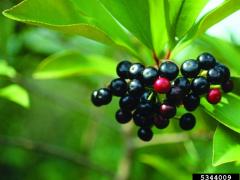Invasive Species: Ardisia elliptica, Shoebutton Ardisia
Shoebutton ardisia is an invasive tall shrub or small tree that can reach a height of 20 ft. (6.1 m). The leathery leaves are 3 to 6 in. (7.6 to 15.2 cm) long, 1 in. (2.5 cm) wide, elliptical, and entire. Most flowering occurs in the summer, but flowering can continue year-round. The flowers are small, pink, and star-shaped and hang in clusters from the axils of the leaves. The berrylike fruit contains a single seed. The fruits change from white to red to purple and then to black when fully ripe. Shoebutton ardisia grows well in low, wet areas and in old fields. This species is shade tolerant. Shoebutton ardisia is a native of Southeast Asia and was introduced in the United States as an ornamental plant in the late 1800s.
What are invasive species, and why should we be concerned about them?
Taxonomy: Scientific and Common Names for This Species
Primulales > Myrsinaceae > Ardisia elliptica Thunb
Synonyms: shoebutton, inkberry, seashore ardisia
Ardisia elliptica – USDA PLANTS Profile
Distribution Maps
shoebutton ardisia – The reported distribution of this invasive species across the United States (Source: Invasive Plant Atlas of the United States)
Up-to-the-minute distribution maps and why they are important
Reporting This Invasive Species
What is the best way to report the occurrence of an invasive species?
How to report an invasive species sighting to EDDMapS – Early Detection & Distribution Mapping System
EDDMapS – Report an invasive species to EDDMapS.
County Extension Offices – Find your county Extension office on this map provided by USDA.
How to Identify
This invasive species can be identified by looking for the characteristics described in the paragraphs that follow.
Shrub
It is a tall shrub or small tree that can reach a height of 20 ft. (6.1 m).
 |
 |
| Tony Pernas, USDI National Park Service, bugwood.org | Forest and Kim Starr, Starr Environmental, bugwood.org |
Foliage
The leathery leaves are 3 to 6 in. (7.6 to 15.2 cm) long, 1 in. (2.5 cm) wide, elliptical, and entire.
 |
 |
| Dan Clark, USDI National Park Service, bugwood.org | Forest and Kim Starr, Starr Environmental, bugwood.org |
Flower
Most flowering occurs in the summer, but flowering can continue year-round. The flowers are small, pink, and star-shaped and hang in clusters from the axils of the leaves.
 |
 |
| Forest and Kim Starr, Starr Environmental, bugwood.org |
John M. Randall, The Nature Conservancy, bugwood.org |
Fruit
The berrylike fruit contains a single seed. The fruits change from white to red to purple and then to black when fully ripe.
 |
 |
| Amy Ferriter, State of Idaho, bugwood.org | Ken A. Langeland, University of Florida, bugwood.org |
Native Species That Resemble Shoebutton Ardisia
– Images at invasive.org
| bugwood.org | bugwood.org |
– Images at invasive.org
| bugwood.org | bugwood.org |
Additional Images for Shoebutton Ardisia
shoebutton ardisia – Images at invasive.org
Learning Resources for Shoebutton Ardisia
Additional Information, Biology, Control and Management Resources
Control and management recommendations vary according to individual circumstances. Location, habitat, weather, and a variety of other conditions are factors that help determine the best treatment choice. To find the safest and most effective treatment for your situation, consult your state’s land-grant institution. If you will use chemicals as part of the control process, always refer to the product label.
United States Land Grant University System – Find your Land Grant University’s College of Agriculture, University Cooperative Extension Service, or other related partner on this map provided by USDA.
Center for Invasive and Aquatic Plants – University of Florida, Institute of Food and Agricultural Sciences (IFAS) Extension
Species Inventory – Smithsonian Marine Station
ID Book – Florida Exotic Pest Plant Council (FLEPPC.org)
Shoebutton ardisia – USDA Forest Service
